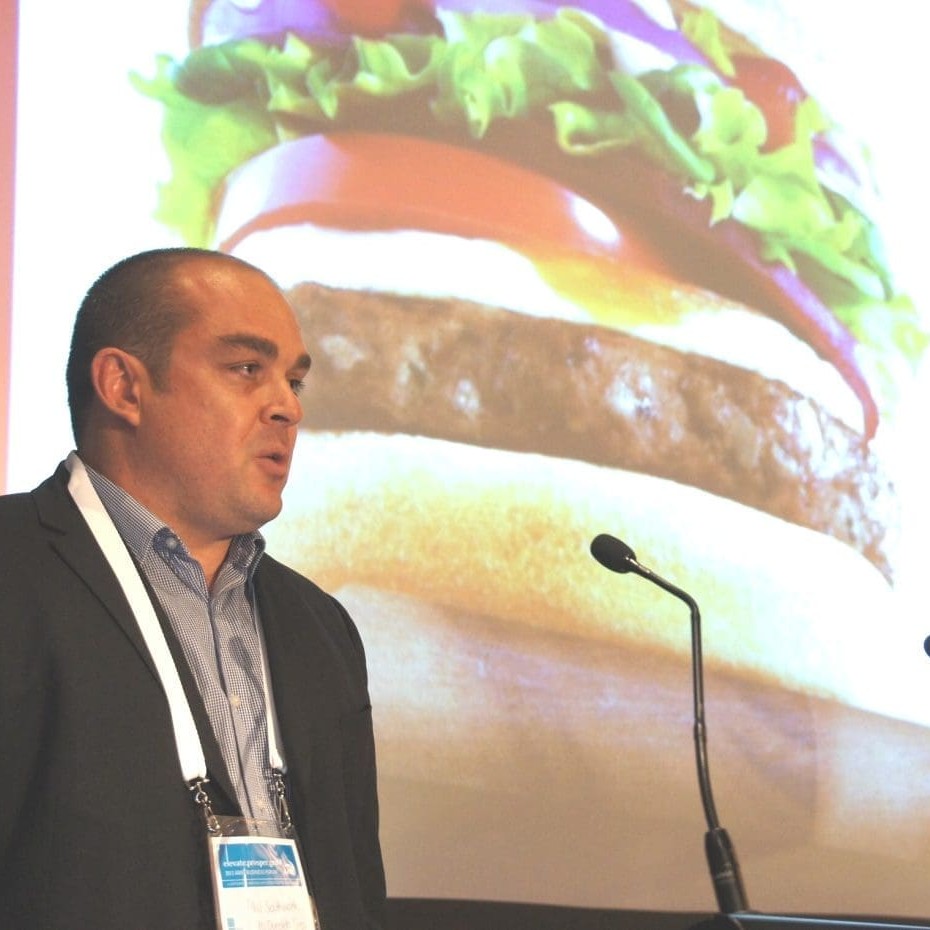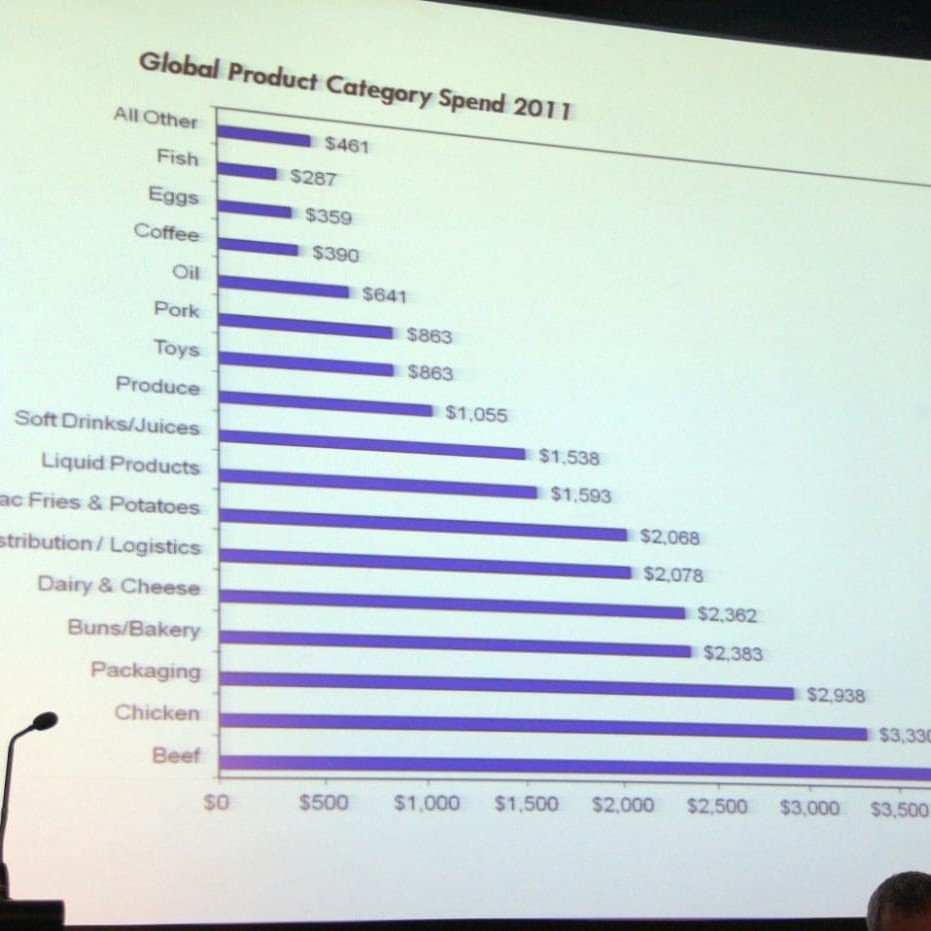 With a 28 percent increase in customer visits and 54pc lift in turnover globally since 2008, its little wonder that one of the big supply chain issues faced by McDonald’s is in sourcing adequate supplies of raw material.
With a 28 percent increase in customer visits and 54pc lift in turnover globally since 2008, its little wonder that one of the big supply chain issues faced by McDonald’s is in sourcing adequate supplies of raw material.
Delegates attending the Australian Meat Industry Council business forum in Adelaide recently were told that supply, and how it is matched to company growth, was one of the fundamental challenges faced by the global burger giant.
Philip Southworth, McDonald’s purchasing manager for Australia/NZ, said the company last year was operating in 118 countries, serving more than 68 million customers every day, with sales topping US$85 billion, up 54pc since 2008.
In stark contrast with many other sectors of business hard-hit by the four-year global economic downturn, McDonald’s continues to show positive growth in comparable store sales year-on-year.
The main reason, as has been widely discussed earlier, is the more defensive buying patterns among consumers everywhere, trading down from more expensive meat items when dining out into a burger option. Add to that the economic growth being seen in developing economies, providing more disposable income for eating out, and McDonald’s is currently in a strong, counter-cyclical position compared with many other food service segments.
“Our global priorities are about optimising the menu, modernising the restaurant experience and broadening accessibility – all of which are about the customer,” Mr Southworth told the forum.
Lamb burger result ahead of budget
Part of that was about innovating, and getting new products into the stores to keep consumers stimulated. Good examples of that in the Australia/NZ region included the highly successful certified Angus burger range release in 2010, and most recently, the launch of a lamb burger.
“We knew a little about beef, but very little about lamb,” Mr Southworth said.
“But we’ve been working on the lamb project for the past 18 months, and learned a lot along the way, examining potential supply and testing the product amongst consumers.”
Currently there were about 20 certified raw suppliers in Australia and NZ to the lamb program.
“We didn’t want to launch something which then failed to get traction, or deliver incremental sales,” he said.
Being an entirely new protein source, McDonald’s had had to create a new pattie that had not been tried anywhere else in the world. That is not that unusual in the Australasian region, however, which has been used to trial other products later taken into international markets.
“We did a lot of consumer insight work on a qualitative and quantitative basis. Surprisingly, right through that development process, our intentions did not get out to the broader market,” he said.
The lamb burger, introduce during August, is going well for McDonald’s, running better than forecast in terms of sales.
 “Interestingly enough, we’re seeing a similar trend as that which we saw with the Angus launch. Our regional, provincial and rural stores are embracing the lamb burger considerably more than what our metropolitan customers are.
“Interestingly enough, we’re seeing a similar trend as that which we saw with the Angus launch. Our regional, provincial and rural stores are embracing the lamb burger considerably more than what our metropolitan customers are.
“We’re seeing stores in regional areas recording massive volume turnover in the lamb burger, which appears to be driven by the fact that these regions are more closely involved with lamb, as a commodity,” Mr Southworth said.
Despite the success of regional product launches like the lamb burger, beef is still critical to the McDonald’s global business. As the image here shows, the company spent about $3.85 billion on beef purchases worldwide last year. While poultry volume is growing, beef remains critical to the McDonald’s business, on a global scale.
“The Big Macs and cheese burgers remain a core part of our business,” Mr Southworth said.
So where does McDonald’s see its beef supply chain going in the next five years?
The big challenge would be in keeping up with company expansion – globally, across the Asian Pacific region, and even within Australia. The company opened a further 1000 stores globally in 2011, and this year will see an additional 1500 restaurants, including another 35 in Australia.
The biggest growth is happening across the so-called APMEA region – Asia-Pacific, Middle East/Africa. China is the single biggest target across the APMEA zone, accounting for an additional 1000 stores alone over the next three years.
“But we’re also seeing growth in other parts of the APMEA region. It’s not only about China, there will be 3100 new stores operating across the region by 2014,” Mr Southworth said.
McDonald’s challenge was to find suitable suppliers of raw material to feed this growth.
While Australia’s supply of grinding meat into the US program was continuing at similar volumes as had been seen earlier, in proportional terms, a lot more was now going into McDonald’s APMEA region, which was all incremental business.
While supply volume was a big challenge, the other elements of McDonald’s ‘Three legged stool’ principle could not be compromised along the way, Mr Southworth said.
One of these legs was food safety and product integrity.
“We can’t afford to have one customer go to a McDonald’s and come away with a food-borne illness. With social media the way it is emerging, any such news quickly reaches consumers – it is instantaneous. We can’t afford for that to occur.”
“In addition to that, we need to have this mentality of continuous improvement. We’re constantly pushing our suppliers to provide new innovative ideas that will make the McDonald’s business better than it was.”
Mr Southworth said predictable, competitive pricing was important to the McDonald’s business.
“We don’t have the ability to change our menu boards regularly, like a petrol station does with fuel,” he said. “Those menu board prices need to be consistent for long periods, and that means food ingredient costs that come through the back-door of each restaurant need to be consistent as well.”
“It needs to be predictable pricing, competitive and stable, so that we can take away any concern among our licensees and the cooperative generally about fluctuations and spikes in raw material cost. That way, they can focus on what their primary job is: to serve the customer and make sure their experience coming into the store is second to none.”
Questioned about McDonald’s approach to environmental and animal welfare standards, the forum was told the company had made a formal commitment to global sustainable initiatives, and beef was one of the areas of focus for that.
“It is becoming a higher priority to gather together information about what the customer wants to see in our product. They want to know about the provenance of the product they are about to consume, and for a lot of them – especially among the ‘Gen Y’s’ – want to know whether it is sustainable, which gives them the ‘permissability’ to consumer the product.”
“So yes, we are committed to sustainability, which we categorise using the three ‘E’s’ – economic, environmental and ethical.”
This was still work in progress for the company, and in the case of beef, standards were still being identified. But there were already well-established principles including activity like animal welfare plant audits, but such moves had to be based in commercial reality.
-
Tomorrow: MAC Asia Pacific’s role in evening-out McDonald’s supply and price challenges.
